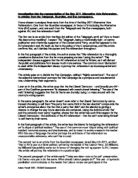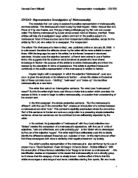Line 23, the author uses an embedded subordinate clause to represent the WAGs as animal-like. “born and bred in Busby, in Glasgow‘s southern suburbs”. The author uses this embedded subordinate clause to add extra information to the article which helps build up representations of the WAGs. He builds up the representation of WAGs being animals as he uses the dynamic verb, “bred”. The author could have used another verb such as “raised” which makes the WAGs sound as if they were brought up in a classier way, rather than “bred” which is often a verb associated with animals, i.e. dogs, which makes them sound as if they were brought up roughly. This is downgrading to the WAGs.
“LOOK AT MY WAD” by The Daily Mirror
The headline of the article is a imperative and exclamatory sentence containing a first person pronoun. “LOOK AT MY WAD” “WAD” is a play-on-words of the word “WAG” as they sound similar, but “WAD” is a slang word often used to describe a bundle of something. For example “a wad of cash”. This represents WAGs the same as they were represented in the previous article - as rich gold-diggers. Also, the use of the pronoun “MY” represents the WAGs as self-centred, in the spotlight, talking about themselves, and the use of imperative and exclamatory sentences represents the WAGs as loud and demanding, fitting their stereotype of being “high maintenance” .
The first line of the declarative, compound sentence, containing a subordinate embedded clause. “WE’VE had WAGs and now WOWs - Wives of Wimbledon - thanks largely to this newspaper” Part of the compound sentence “…and now WOWs” places WAGs and WOWs in the same category through use of the word “and”. If they are in the same category, this suggests that they share the same representation. In text A, wags were represented as gold-diggers who were inferior to everyone else, so WOWs could now share this representation. The subordinate embedded clause “Wives Of Wimbledon” is used to elaborate what a WOW is. It is similar to WAG (wives and girlfriends) so it reinforces the representation made of WAGs. “thanks largely to this newspaper” suggests that The Daily Mirror creates these representations rather than the author himself.
The following sentence of the one above starts with a conjunction “and”. “And now my wife Mindy…”. The previous sentence ends will a full stop to avoid the use of a compound sentence, therefore separating WAGs and WOWs from the author’s wife, Mindy. This places Mindy in a different position to the WAGs and WOWs, and detaches her from the negative representations made of them.
This text reinforces all the representations made in Appendix A by separating everyday people from WAGs (and WOWs) by making everyday people superior and WAGs inferior and frowned upon for their lifestyles.
Crouch Is So Abi With The New Girlfriend by The Sun
This article creates a different representation of WAGs. It portrays them in a more positive light as being equal in society and not portrayed as inferior to the reader. The article also doesn’t follow the same negative and degrading representations of The Daily Telegraph and The Daily Mirror.
The article opens with a declarative sentence. “Peter’s girlfriend…Abigail Clancy”. The article doesn’t introduce Abigail as a WAG like the previous articles. The article gives her a more respectable title of “girlfriend”, rather than labelling her as a WAG like the previous articles. This makes her equal to the reader, as girlfriends/boyfriends of the reader will also be referred to as “girlfriend” or “boyfriend”
However, some would argue the main clause is arranged in a way that makes Abigail look like Peter’s object and make her of lesser importance. “Peter’s girlfriend” represents Abigail to be in Peter’s possession as if he owns her. The second part of the clause names Peter’s girlfriend “Abigail Clancy” which suggests she is of lesser importance than Peter, representing her as inferior.
The text also uses a declarative sentence to create a picture of Peter‘s new girlfriend. “This is the beauty putting a spring of the step of beanpole striker Peter Crouch”. The sentence represents Abigail as beautiful and making a positive impact on Peter’s life, whereas in the previous articles, girlfriends ad wives of footballers were made out to be a burden and an embarrassment through their activities and lifestyles. The sentence is declarative, so it makes a statement, which the reader is unlikely to doubt or question. This will encourage the reader to think of girlfriends of footballers in a positive light as they make a positive impact on the footballers.
The final sentence in the text is a declarative, containing a subordinate embedded clause, set in the future tense. “Abigail is set to appear in the new series of Britain’s Next Top Model, starting on July 24 on Living TV” This declarative sentence is used to make a statement about Abigail’s lifestyle, and reader’s can make a judgement upon this statement. This sentence is implying that Abigail doesn’t follow the typical lifestyle that represents WAGs as “being immoral, rich, gold-diggers” as represented in The Daily Telegraph. The declarative sentence, set in the future tense, shows that Abigail has goals and aspirations of her own for the future, and is not dependant on her boyfriend’s money to take part in activities such as “shopping by day and partying by night” (as mentioned in The Daily Telegraph). The subordinate, embedded clause is used at the end of the sentence “…starting on July 24 on Living TV”, is a subordinate embedded clause as it gives extra information to the main clause and is dependant on the main clause to make sense. This is used to promote Abigail, and implies the reader should watch the programme, rather than criticising her for her lifestyle.
In conclusion, there are both different and similar representations made of the WAGs between the three texts. The language and the attitudes of the newspapers are designed to shape the reader’s response to WAGs, allowing them to make a judgement on them and their lifestyles. The articles generally build up a negative representation of WAGs. The first two articles label them as WAGs which make them inferior as they are under possession of their husbands and boyfriends. Dynamic verbs such as “shopped” and “partied” used in The Daily Telegraph represents them as immoral as they don’t work for this lifestyle, and also makes them out be irresponsible and dependant as the rely on the boyfriend’s and husband’s wages for this kind of lifestyle.
However, the final article from The Sun offers a more positive representation. The first two articles use the term “WAGs” as a collective noun - grouping all footballer’s wives and girlfriends together, assuming they follow the same lifestyle that is portrayed in a negative light and frowned upon by the reader. The Sun does not bind all WAGs together in one category. Instead, the article focuses on one “WAG” in particular, who is not once referred to as a WAG in the article - she is given the more respectable title of “girlfriend”. The article shows that she does not follow the stereotypes of WAGs that the first two articles present. The article treats her as a respected individual who has her own goals and is not dependant on her boyfriend.
Overall, language is a big factor when it comes to the articles creating representations. With negative representations, declarative statements are used to make negative judgements, pre-shaping the readers response. For example, in the first article: “They shopped by day and partied by night”. This is a judgement made on the WAGs, rather than just stating their activities, because the article is implying they are rich gold-diggers, and the reader is likely to judge in the same way. On the other hand, The Sun uses declarative sentences to made positive statements, which allows the reader to make their own judgement. For example: “Abigail is set to appear in the new series of Britain’s Next Top Model, starting on July 24 on Living TV”. This statement allows the reader to make their own judgement. Some readers will interpret this as Abigail making her own path in life and not being independent on her boyfriend. Other, more critical readers, may represent this as Abigail being “into her looks” and going on a Model show on TV to show off, like other typical WAGs.







